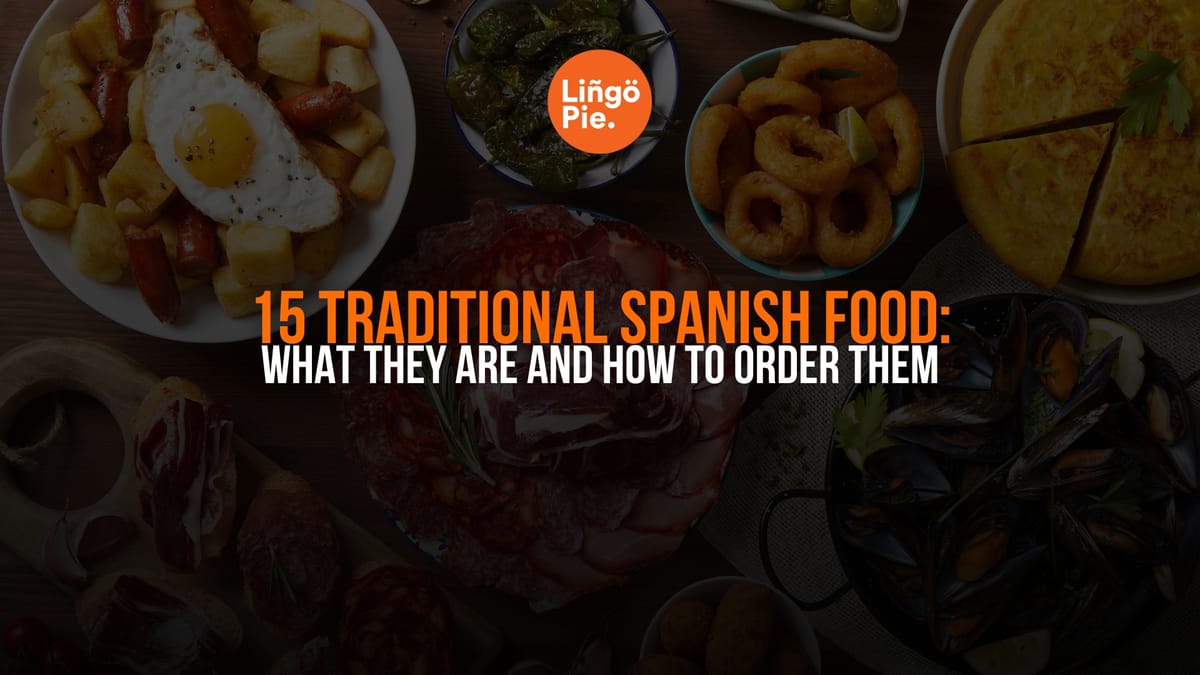Planning to visit Spain or just want to check out that pop up Spanish resto in your neighborhood? Spanish food is way more diverse than most people think. Sure, everyone knows paella and tapas, but Spain has 17 different regions, each with their own signature dishes and local specialties.
This guide covers everything you need to know: how to actually order food in Spanish (the practical stuff), what traditional dishes to try, and the cultural context that makes Spanish food so special. Let's level up your Spanish, shall we?
- 4 Seasons In Spanish: A Vocab Guide For Beginners
- Months And Dates In Spanish: A Beginner’s Guide
- 17 Best Shows To Watch To Learn Spanish On Netflix

How to Order Food in Spanish
Let's start with the practical stuff—you need to eat, and you want to do it in Spanish. Here are the essential phrases that'll get you fed and sounding confident.
Making a Reservation and Getting Seated
- "Quisiera hacer una reserva para [number] personas" - I would like to make a reservation for [number] people
- "¿Tienen mesa para dos?" - Do you have a table for two?
- "¿A qué hora cierran la cocina?" - What time does the kitchen close?
- "Tengo una reserva a nombre de [name]" - I have a reservation under [name]
- "¿Podríamos sentarnos en la terraza?" - Could we sit on the terrace?
- "¿Hay que esperar mucho?" - Is there a long wait?
Essential Ordering Phrases
- "¿Podría ver la carta, por favor?" - Could I see the menu, please?
- "¿Cuál es el plato del día?" - What's the dish of the day?
- "¿Qué me recomienda?" - What do you recommend?
- "¿Cuál es la especialidad de la casa?" - What's the house specialty?
- "Voy a pedir..." - I'm going to order...
- "Para mí, [dish name]" - For me, [dish name]
- "Quiero..." - I want...
- "Me pone..." - Give me... (very common in Spain)
- "¿Estamos listos para pedir?" - Are we ready to order?
- "¿Qué tienen para beber?" - What do you have to drink?
- "Una cerveza, por favor" - A beer, please
- "Un vaso de agua" - A glass of water
- "La carta de vinos" - The wine list
- "¿Tienen sangría?" - Do you have sangria?

Dietary Restrictions and Special Requests
- "Tengo alergia a..." - I'm allergic to...
- "No puedo comer..." - I can't eat...
- "Soy vegetariano/a" - I'm vegetarian
- "Soy vegano/a" - I'm vegan
- "¿Tiene opciones sin gluten?" - Do you have gluten-free options?
- "¿Lleva frutos secos?" - Does it contain nuts?
- "¿Podría preparar mi plato sin...?" - Could you prepare my dish without...?
- "¿Está muy picante?" - Is it very spicy?
- "¿Viene con guarnición?" - Does it come with a side dish?
Finishing Your Meal
- "La cuenta, por favor" - The check, please
- "¿Puedo pagar con tarjeta?" - Can I pay by card?
- "¿Aceptan euros?" - Do you accept euros?
- "¿Está incluida la propina?" - Is the tip included?
- "Gracias, todo estaba delicioso" - Thank you, everything was delicious
- "¡Buen provecho!" - Enjoy your meal! (say this before eating)
- "¡Qué aproveche!" - Another way to say "enjoy your meal"
Want to learn more on how to order food in Spanish? Be sure to check our guide!
Traditional Spanish Food
Now that you know how to order, let's talk about what to order. Spanish cuisine varies dramatically by region, but these dishes represent the heart of traditional Spanish cooking.

Traditional Spanish Breakfast
Spanish breakfasts are simple but satisfying, focusing on quality ingredients rather than large portions. Most Spaniards eat a light breakfast around 7-10 AM, saving their appetite for the substantial midday meal.
Tostada con Tomate y Aceite
The foundation of Spanish breakfast culture is toasted bread rubbed with fresh garlic, topped with grated tomato, and drizzled with extra virgin olive oil. In Andalusia, you might find manteca colorá (spiced lard) as a heartier alternative. It's simple, but when made with perfectly ripe tomatoes and high-quality olive oil, it's absolutely perfect.
Churros y Chocolate
Contrary to popular belief, churros are a traditional breakfast food in Spain, not a dessert. These golden, ridged pastries are served with thick, rich hot chocolate for dipping—think warm pudding consistency, not thin American hot chocolate. The combination of crispy churros and velvety chocolate is pure morning magic.
Pan con Tomate (Pa amb Tomàquet)
Catalonia's signature breakfast combines toasted bread rubbed with ripe tomatoes, garlic, olive oil, and salt. This dish dates back to the 18th century when Catalan peasants needed ways to soften day-old bread. Sometimes served with cheese or ham, but the basic version is surprisingly satisfying.
Tortilla Española
Spain's beloved potato omelet appears on breakfast tables throughout the country. Made with eggs, potatoes, and sometimes onions (the great Spanish debate), this thick, cake-like omelet can be enjoyed warm or at room temperature. A "pincho de tortilla" (slice of omelet) is the perfect grab-and-go breakfast.
Café con Leche
No Spanish breakfast is complete without this perfect balance of strong coffee and hot milk. The preparation involves making espresso and heating milk just below boiling before combining them. It's the fuel that powers Spanish mornings.

Traditional Spanish Appetizers and Tapas
Tapas culture defines Spanish dining—these small plates encourage slow eating, conversation, and community. The tradition supposedly began in Seville when bartenders covered wine glasses with small plates (tapas means "covers") to keep flies away.
Patatas Bravas
Spain's most popular tapa features crispy fried potato cubes topped with spicy salsa brava (brave sauce) and sometimes garlic aioli. Originally from Madrid, this dish is now found in every Spanish bar. The key is getting the potatoes crispy outside and fluffy inside, then drowning them in that smoky, slightly spicy red sauce.
Jamón Ibérico
This premium cured ham comes from black Iberian pigs that roam oak forests, feeding on acorns. The result is ham with incredible marbling and a rich, nutty flavor that melts in your mouth. Spanish artisans cure their ham for at least twelve months, creating one of the world's finest charcuterie products.
Croquetas
These golden, crispy fritters hide a creamy béchamel interior mixed with various fillings like ham, cod, or cheese. The perfect croqueta has a crunchy exterior that gives way to molten, flavorful cream inside. They're bite-sized pieces of comfort food that pair perfectly with Spanish wine.
Gambas al Ajillo
Large shrimp sautéed in bubbling olive oil with garlic and chili creates one of Spain's most aromatic tapas. The dish arrives at your table still sizzling, filling the air with garlic-infused steam. The best way to enjoy it is with crusty bread to soak up that incredible garlicky oil.
Pimientos de Padrón
These small green peppers from Galicia are flash-fried in olive oil and sprinkled with coarse salt. Most are mild, but occasionally you'll bite into a spicy one—that's part of the fun. They're impossibly simple yet completely addictive, especially with a cold beer.

Traditional Spanish Lunch and Dinner Foods
Spanish lunch (comida) is the main meal of the day, typically served between 2-4 PM. These hearty dishes reflect Spain's agricultural heritage and regional diversity.
Paella Valenciana
Spain's most famous dish originated in Valencia's rice fields during the mid-19th century, cooked by farmers over open fires. Traditional paella contains rice, saffron, chicken, rabbit, green beans, and sometimes snails—no seafood in the original version. The prized socarrat (crispy rice layer at the bottom) is considered the best part by locals.
Gazpacho Andaluz
This refreshing cold soup from Andalusia combines ripe tomatoes, cucumber, bell peppers, onion, garlic, bread, olive oil, and sherry vinegar. Perfect for scorching summer days, gazpacho can be served as a drink or eaten from a bowl with garnishes. Many Spaniards consider it the ultimate hangover cure and general life remedy.
Cocido Madrileño
Madrid's signature three-course stew features chickpeas, various meats (chorizo, ham, chicken, beef), and vegetables cooked together in one pot. Traditionally served in stages: first the broth with noodles, then the vegetables and chickpeas, finally the meat. It's hearty winter comfort food that can easily feed a crowd.
Fabada Asturiana
This rich bean stew from Asturias combines large white beans (fabes) with chorizo, blood sausage (morcilla), and various pork cuts. Slow-cooked until creamy and intensely flavorful, fabada is best shared among several people—it's incredibly filling. This dish represents the robust, hearty cuisine of northern Spain.
Bacalao al Pil Pil
This Basque masterpiece showcases cod in a sauce created by emulsifying the fish's natural gelatin with olive oil and garlic through constant gentle swirling. The technique creates a creamy, pale green sauce without any cream or egg. It's pure culinary magic that demonstrates Basque cooking prowess.

Other Popular Spanish Foods You Can Order
Spanish cuisine reflects centuries of cultural exchange. Romans introduced olive oil and wine cultivation, Moors brought rice and saffron, and New World ingredients like tomatoes and peppers arrived after 1492. This layering of influences created the complex, varied cuisine we know today.
In this section, let's go over the other popular options that also showcase regional specialties and modern favorites you'll find throughout Spain.
| Dish | Region | Description | When to Order |
|---|---|---|---|
| Pulpo a la Gallega | Galicia | Tender octopus with potatoes, olive oil, and paprika | Perfect appetizer |
| Escalivada | Catalonia | Roasted vegetables with olive oil | Great vegetarian option |
| Salmorejo | Córdoba | Thick, creamy cold soup, gazpacho's cousin | Summer starter |
| Migas | Various regions | Fried breadcrumbs with chorizo and vegetables | Hearty comfort food |
| Crema Catalana | Catalonia | Custard with caramelized sugar crust | Classic dessert |
| Cochinillo Asado | Segovia | Roasted suckling pig | Special occasion dish |
| Lentejas con Chorizo | Throughout Spain | Lentil stew with chorizo | Warming winter meal |
| Pisto Manchego | La Mancha | Spanish ratatouille with vegetables | Light, healthy option |
Ready To Level Up Your Spanish Further?
Looking to turn your newfound Spanish food vocabulary into actual conversations? Lingopie lets you feast on authentic Spanish content while painlessly building your language skills.
Unlike boring textbooks that teach you how to say "the cat is on the table" (when was the last time you needed that?), Lingopie immerses you in real Spanish shows where you'll hear locals ordering "una caña y patatas bravas" or debating the perfect tortilla recipe.
Lingopie's interactive dual subtitles also let you tap any unfamiliar word and instantly learn what it means. By the time you land in Madrid or Barcelona, you won't just know what to order; you'll understand the locals' recommendations and might even charm your server with some proper Spanish.
¡Buen provecho to your language journey!




![Are You A Gabacho, Gringo, Or Güero? [Spanish Slang Guide]](/blog/content/images/2025/06/Gabacho-Meaning.jpg)

![30+ Modern English Slang Terms For Money [Guide]](/blog/content/images/size/w300/2025/06/Slang-term-for-money.jpg)
![5 Official Spanish Language Tests To Show Your Proficiency Level [Guide]](/blog/content/images/size/w300/2025/06/Spanish-Language-Tests.jpg)

![Why Memorizing Spanish Words Won’t Make You Fluent [Tips]](/blog/content/images/size/w300/2025/06/how-to-practice-spanish-vocabulary.jpg)